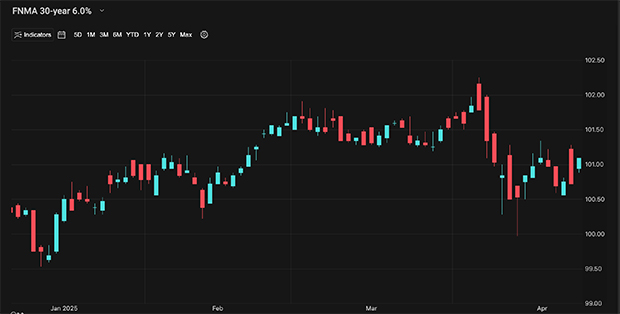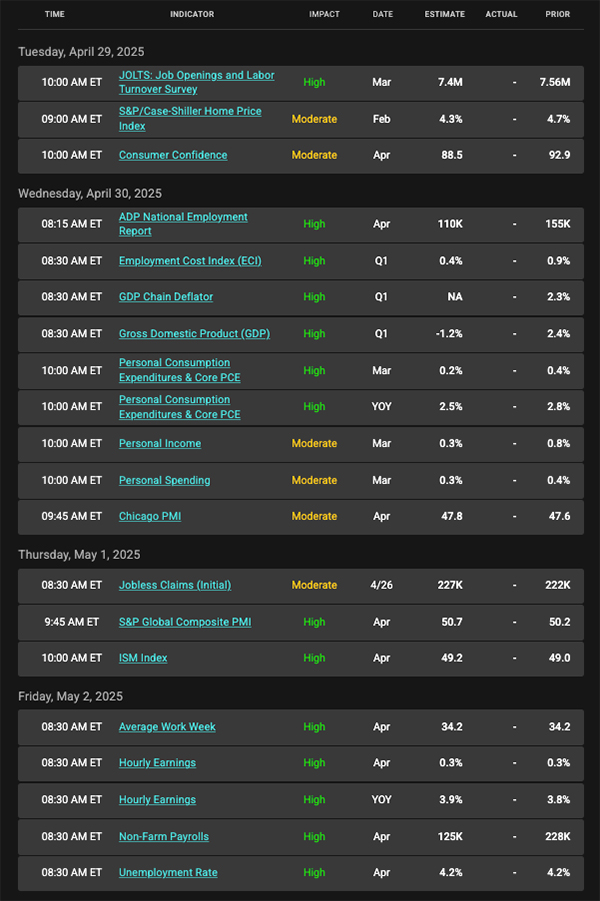Please note: While we live and breathe Non-QM, we know the bigger picture matters. This update looks at the broader mortgage market because what’s happening out there impacts everyone—borrowers, brokers, and lenders alike.
 Volatility was back again this week with markets moving all over the place. Let’s review last week’s events and preview what’s ahead.
Volatility was back again this week with markets moving all over the place. Let’s review last week’s events and preview what’s ahead.
Tariff Uncertainty
Uncertainty persists regarding tariffs, supporting bond prices and preventing mortgage rates from rising further. This is evident in the Treasury market, where, on April 11th, the 10-year Note reached 4.60%. Today, it hovers closer to 4.30%.
New Home Sales Surge
This past week brought optimism to the U.S. housing market as new home sales in March soared to a seasonally adjusted annual rate of 724,000 units, a 7.4% increase from February and the highest level since September 2024. Fueled by a dip in mortgage rates and builder incentives, particularly in the South, the surge exceeded expectations of a 1.3% rise. Despite a gloomy economic outlook due to tariff-related uncertainties, robust demand signals resilience in the housing sector, offering hope for buyers and builders navigating a challenging spring season.
Stocks Rebound on Reassuring Words
Stocks struggled early in the week following President Trump’s critical remarks about Fed Chair Jerome Powell, including threats of dismissal. However, by Tuesday, Trump softened his stance, stating in the Oval Office that he had “no intention” of removing Powell, though he urged the Fed chair to be “more active” on rate cuts. This reversal followed market declines driven by fears of a trade war and threats to Fed independence, with the S&P 500 and Nasdaq later gaining 2.5% and 2.7%, respectively.
Meanwhile, U.S. Treasury Secretary Scott Bessent signaled a potential easing of the trade conflict with China, calling the current tariff standoff “unsustainable.” Bessent expressed optimism for a “de-escalation” soon, noting that the 145% tariffs on Chinese goods and China’s 125% retaliatory tariffs, were harming both economies. This view was echoed by global markets, with Asian stocks like Japan’s Nikkei 225 rising 1.9%. However, he cautioned that formal talks had not yet started, suggesting a long road ahead despite Trump’s claim that tariffs would “come down substantially” with a deal.
Treasury Auction Results Mixed
This week’s U.S. Treasury auctions revealed mixed demand amid global trade uncertainties, with foreign buying showing signs of strain. On Tuesday, a $69 billion 2-year note auction saw weaker foreign participation. On Wednesday, a $70 billion 5-year note auction showed slight improvement, with indirect bidders, often a proxy for foreign demand, taking 64% of the auction at a high yield of 3.995%, signaling solid but not robust global interest. This week’s mixed foreign demand does not indicate a buying strike by foreigners, as just a few weeks ago, significant foreign demand was observed for longer-term debt, such as 10-year Notes and 30-year Bonds.
This is an important story to follow, as the United States aims to lower its budget deficit and faces the need to sell more bonds. Fed Chair Powell has repeatedly stated that the “trajectory of our new debt is on an unsustainable path and, ultimately, a threat to our economy.”
30-Year Mortgage Rates
The 30-year fixed-rate mortgage (FRM) averaged 6.81% as of April 24, 2025, down from the previous week’s average of 6.83%.
Bottom Line: Interest rates have remained below key levels since calming statements from the Fed, Jamie Dimon, and Scott Bessent on April 11th. Moving forward, rates are expected to fluctuate, as seen this week, as markets seek more certainty surrounding tariffs.
Looking Ahead
Next week is packed with high-impact economic reports, including the Fed’s preferred inflation gauge, Core PCE, which is expected to fall to 2.5%, the lowest annual reading since April 2021. There will also be key labor market data, such as JOLTS and the April Jobs Report on Friday. Amid these releases, tariff-related headlines will continue to influence markets.
Mortgage Market Guide Candlestick Chart
For homebuyers and refinancers, mortgage rates are critical and closely tied to mortgage bond prices. The chart below tracks the Fannie Mae 30-year 6.0% coupon. The rule is simple: rising bond prices mean falling mortgage rates; falling prices mean rising rates. On the right side of the chart, bond prices have rebounded from recent lows, thanks to reassuring statements from Jamie Dimon, Scott Bessent, and the Fed.
Chart: Fannie Mae 30-Year 6% Coupon (Friday, April 25, 2025)

Economic Calendar for the Week of April 28-May 2

The material contained in this newsletter has been prepared by an independent third-party provider. The content is provided for use by real estate, financial services and other professionals only and is not intended for consumer distribution. The material provided is for informational and educational purposes only and should not be construed as investment and/or mortgage advice. Although the material is deemed to be accurate and reliable, there is no guarantee it is without errors.



